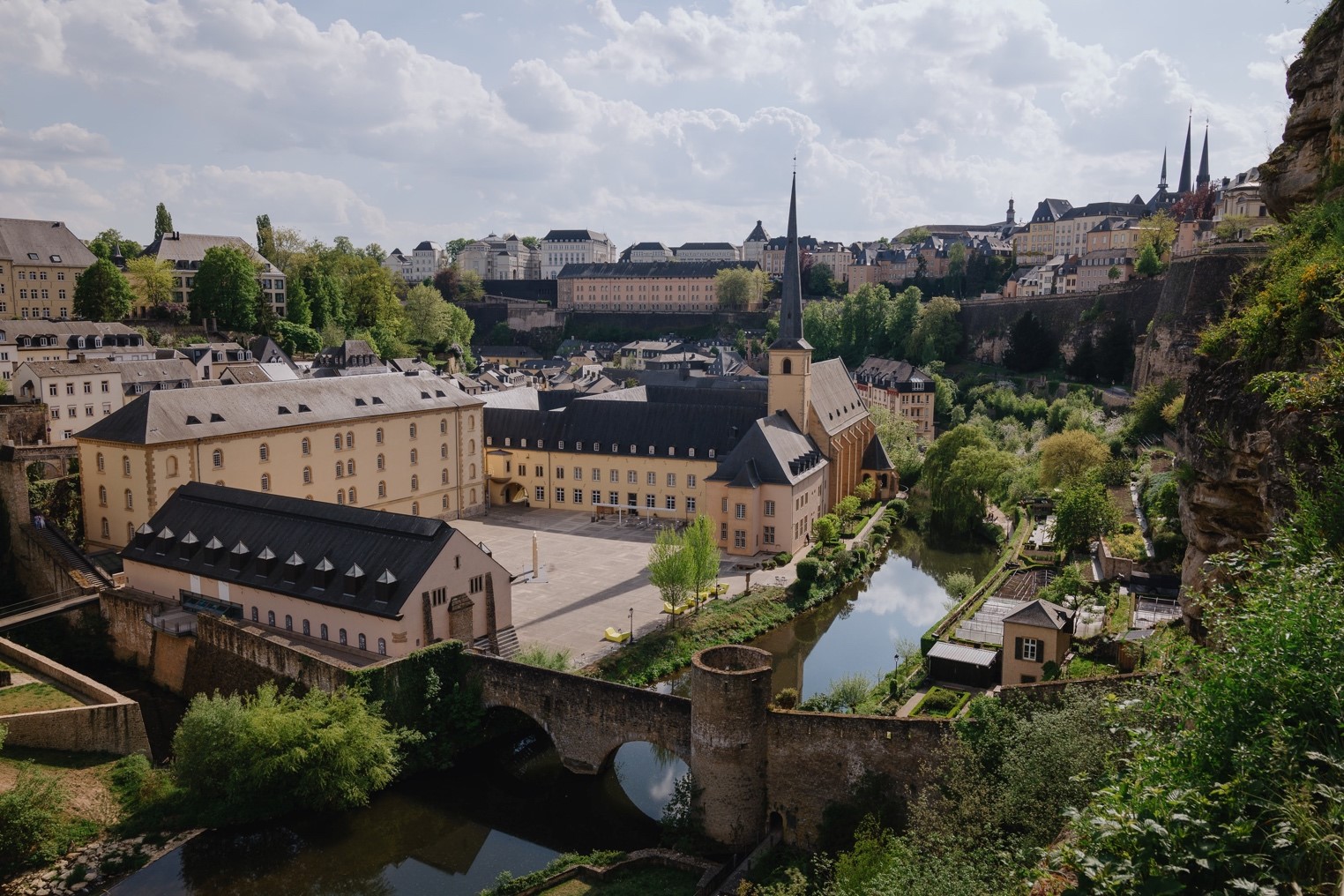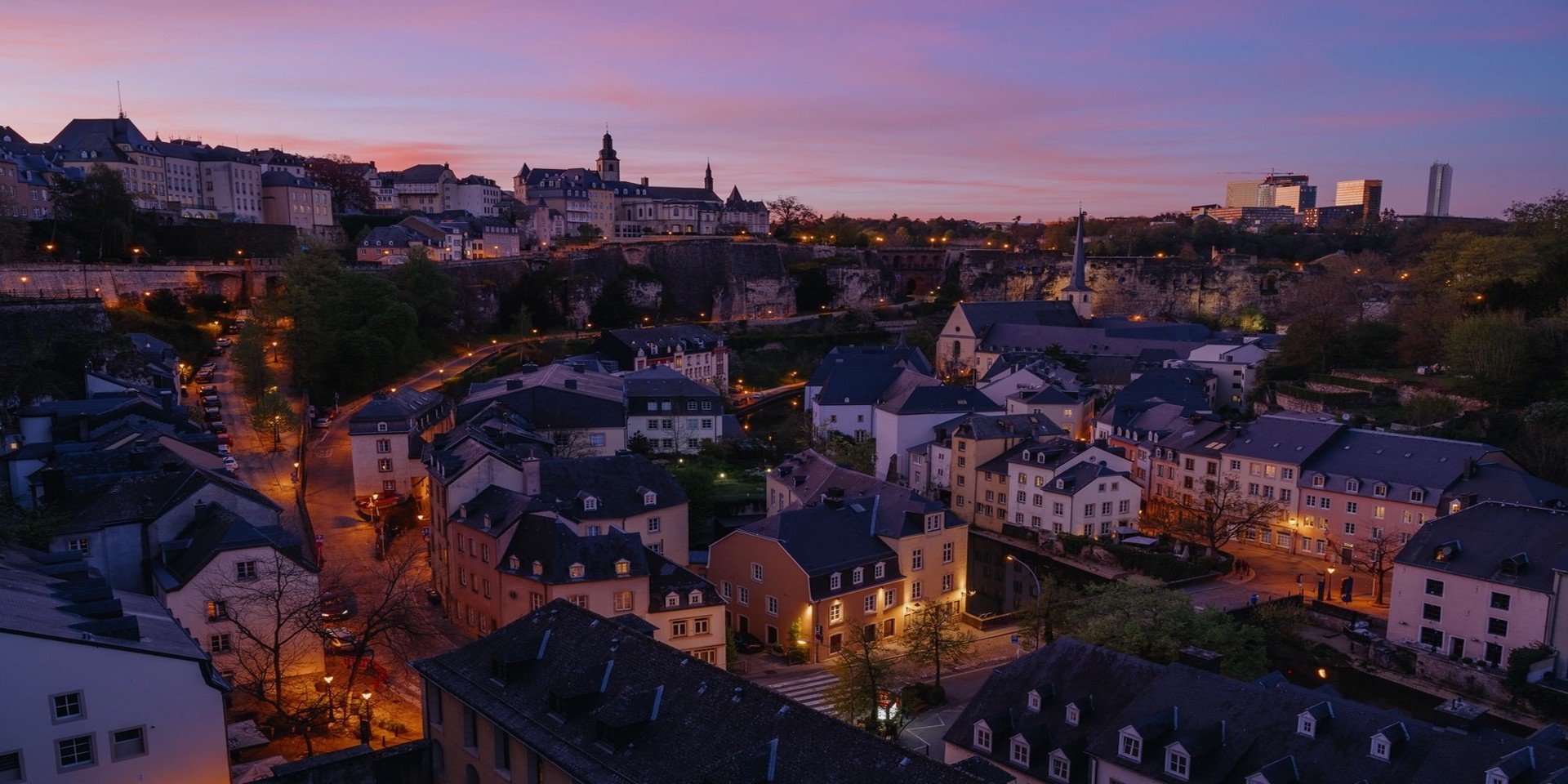22 good reasons to visit Luxembourg City as a Tourist
1. La Passerelle Bridge
“La Passerelle”, built between 1859 and 1861, is a viaduct that crosses “La Pétrusse” Valley connecting the districts of “Gare” and “Ville Haute”, where The Central is located. It is also known as the Old Bridge by Locals: in Luxembourgish “Al Bréck”, in French “Vieux Pont”, in German “Alte Brücke”. The “new bridge” in this comparison is the Adolphe Bridge, which was built between 1900 and 1903.
“La Passerelle” is a good spot to understand the unique structure of Luxembourg City which is really built on two levels. On the upper plateau there is the old fortified town: a maze of pretty streets, historical landmarks, upscale restaurants, museums, and luxury boutiques. In the lower part of the city along the valley you will find more homes, lively restaurants and bars, lush parks and picturesque canals in a remarkable natural setting.
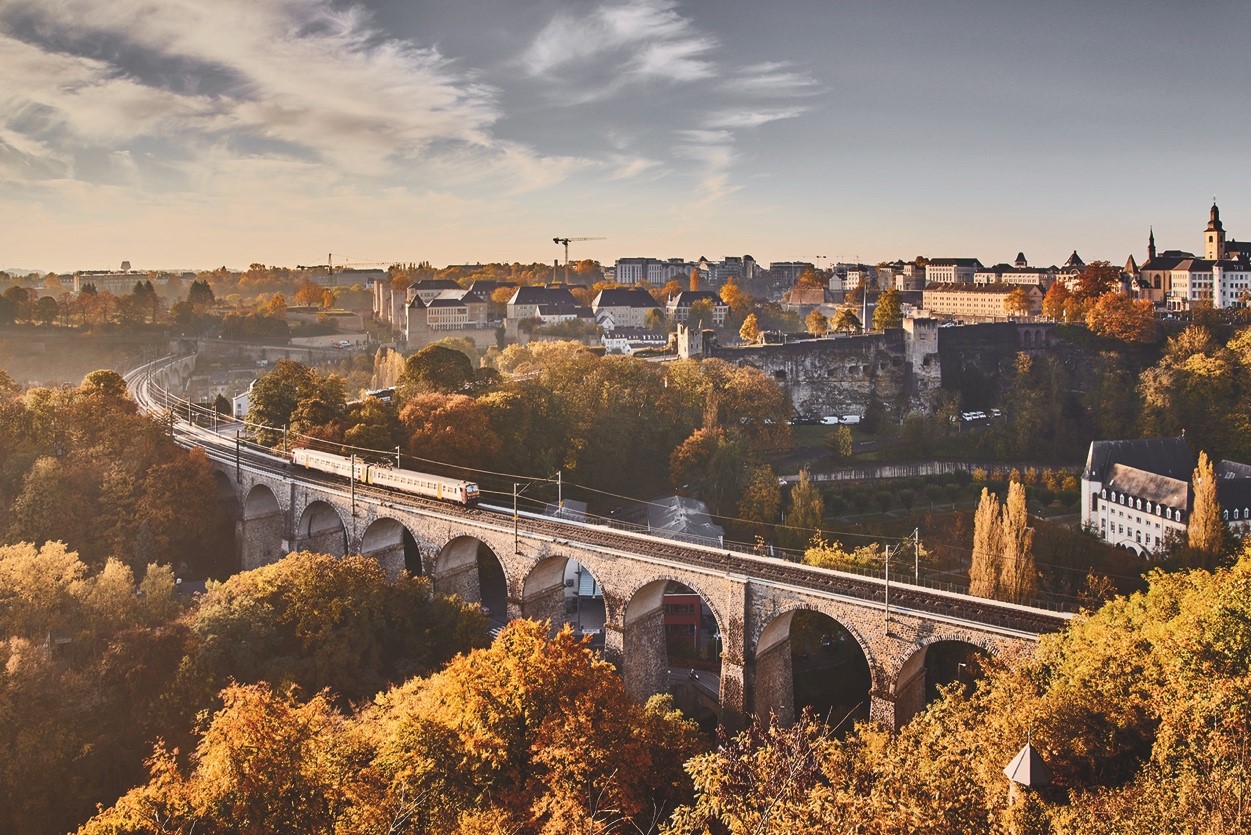
2. Adolphe Bridge
Also called New Bridge, it was erected between 1900 and 1903 during the rule of Grand Duke Adolphe. This event was followed with great interest from abroad, because the bridge had the biggest stone arch in the world up to then. The bridge provides a one-way route for road traffic across “La Pétrusse”, from Boulevard Royal, in Ville Haute, to Avenue de la Liberté, in Gare. Its upper deck is 153 meters in length and carries two lanes of road traffic, and two pedestrian footpaths. Its lower deck, opened in 2018 and suspended beneath the upper deck, carries a dedicated bidirectional bicycle and pedestrian path. Following the completion of the City Tram Line expected in 2020 the bridge will carry also bidirectional tram traffic on its upper deck. The Adolphe Bridge has become one of Luxembourg City’s main tourist attractions and one of the best panoramic points from which to appreciate “La Petrusse” Valley and the historical centre.
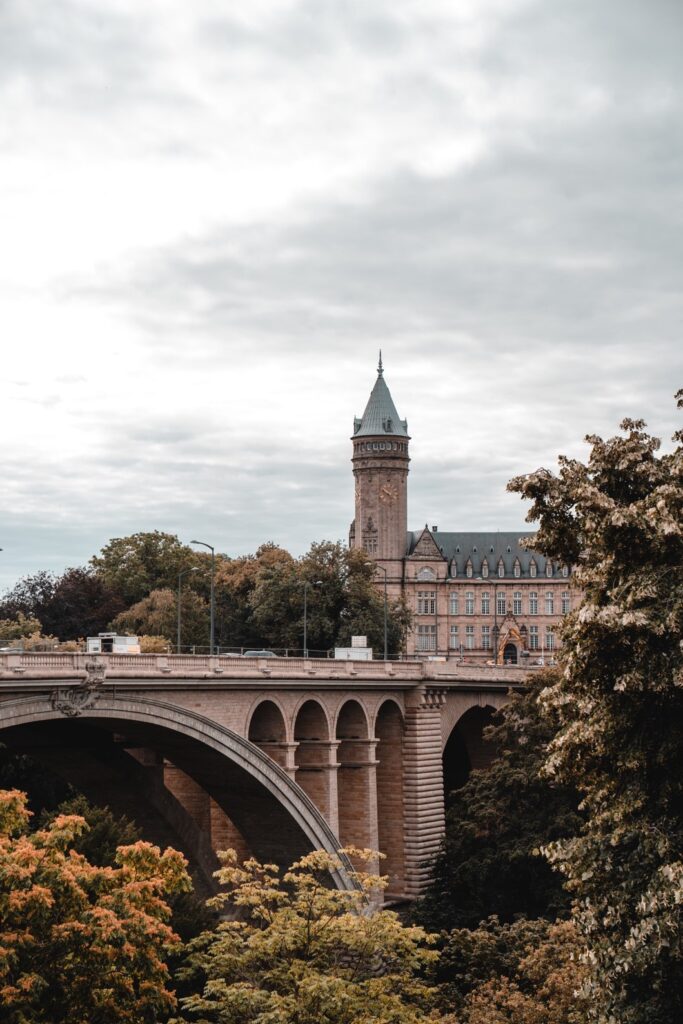
3. Bourbon Plateau
Its name refers to the former Fort Bourbon and it had been included in the fortification of the city for ages. A lot of defence works of the middle and exterior rings of the so-called Diedenhofener Front (for instance Fort Bourbon, Fort Elisabeth, Avancée Thionville, Fort Wallis, Fort Wedell) were located on this plateau which essentially now constitutes the Gare District, where The Central is located. In fact, after the fortress became obsolete around mid-19th century, extensive urban planning projects has been constantly carried out here, starting in 1859 with the construction of the Central Railway Station of Luxembourg. Today it is the ideal neighbourhood if you want to live close to the shops, cafés, restaurants, transports, schools, recreational spaces and most importantly if you want to walk to work and don’t drive.
4. Am Tunnel
Contemporary art gallery located in part of the underground casemates’ tunnels of the city’s ancient fortress, under the Bourbon plateau, in the northern part of Gare quarter. It is connected to the former headquarters of Banque et Caisse d’Épargne de l’État (BCEE), the third-largest bank based in Luxembourg.
In 1987 BCEE launched a plan to extend the former casemate, so that it would connect the bank’s four buildings that lie on the plateau. The possible usage of the tunnel itself was debated, and the idea was formed to turn the tunnel into a gallery. The gallery was opened in 1993. It is primarily dedicated to hosting works by more than a hundred Luxembourgian artists, particularly the photographer Edward Steichen to whom a permanent collection is dedicated.
5. Parks de la Petrusse
Laid out along the green Pétrusse Valley, this stunning public park combine steep slopes, strange rock formations and the ruins of fortifications and bastions to form a harmonious landscape. The City of Luxembourg has designed an ultra-modern skatepark, functioning as a public square with its bleachers and its walkways: it is a meeting place, an ideal playground for board sports enthusiasts. Skateboarding, rollerblading, BMX, scootering, beginners, curious, enthusiasts… The infrastructure allows everyone to learn, discover or practice.
6. Constitution Square – „Gëlle Fra“ Memorial
Among historic monuments in Luxembourg, the Golden Lady on Constitution Square was set up in 1923 to commemorate the Luxembourgers who perished in the First World War. This is probably the first landmark that you will come across while walking from Gare to Ville Haute, being located along the northern’ s edge of the Petrusse Valley between the two bridges that connects these districts. The memorial represents a gold-plated female figure on a stone obelisk. On October 20th 1940 the Nazis pulled the monument down. Only in 1984 after extensive restoration it was brought back to its original appearance. Today it symbolizes freedom and resistance for the Luxembourg people.
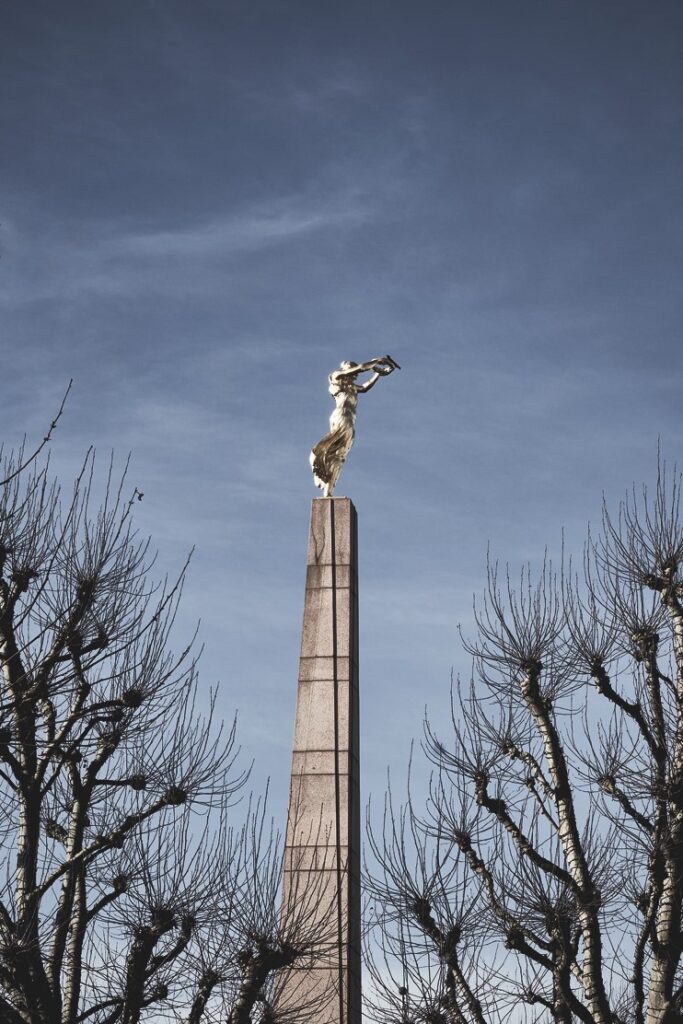
7. Notre-Dame Cathedral
“Kathedral Notre-Dame”, in Luxembourgish, is the Roman Catholic Cathedral of Luxembourg City and the only cathedral in Luxembourg. It was originally a Jesuit church and its cornerstone was laid in 1613. The church is a noteworthy example of late gothic architecture, however also has many Renaissance elements and decorations.
8. Place Guillaume II
The square lies to the west of Krautmaart and to the north of Boulevard Franklin Delano Roosevelt in the heart of Luxembourg’s historic Ville Haute quarter. The western half of the square is dominated by Luxembourg City Hall in the southwest, whilst the equestrian statue to former Grand Duke William II, after whom the square is named, is the prominent feature of the eastern half. The square was originally the site of a Franciscan monastery. However, in 1797, during the French Revolutionary Wars, the monastery was dispossessed by occupying French soldiers. In 1804, the visiting Napoleon presented Place Guillaume II to the city as a gift. In 1829, plans were put in place to build a new town hall on the square, based upon the plans of Belgian architect Justin Remont. That same year, the deconstruction of the former monastery was completed, the material from which was used in the new building. The town hall was completed in 1838 but officially unveiled on 15 July 1844 by Grand Duke William II, as was the statue in his likeness in Place Guillaume II. Place Guillaume II is used as an open-air music venue, hosting the Rock um Knuedler concert each year since 1991. The concerts are free to the public, and have been watched by audiences of up to 10,000.
9. Place d’Armes
It originally served as a parade ground for the troops defending the city. After a huge fire in 1554 destroyed a large part of the Ville Haute, plans were made to lay out a square in the centre of the fortified town. The task was assigned to the Dutch military engineer Sebastian Van Noyen who designed the first version of the square, then known as the Neumarkt, or New Market. In 1671, the Spanish engineer Jean Charles de Landas, Count of Louvigny, produced a slightly smaller square at the same location. It became known as the Place d’Armes as it was used as a parade ground for the garrison. Under Louis XIV, it was paved with flagstones and bordered with lime trees.
Now an integral part of the pedestrian zone, the square is surrounded by numerous cafés and restaurants, all with pavement terraces in the summer months. It has become the city’s main centre of activity, attracting locals and visitors of all ages. Visiting bands and music groups present concerts from the central bandstand every summer evening. Every second and fourth Saturday, there is a flea market and in December the square houses the Christmas market.
10. Shopping in the Old Town
In the Ville-Haute district there are all the famous brands, nice jewelleries, trendy shops, luxury boutiques and plenty of craftsmen, including exquisite chocolate and pastry shops, traditional here. The pedestrian area is a must see: the commercial activities found here are characterized by the architecture of the historical buildings in which they are located, sometime compact and antique, others ultra-modern and very spacious, such as the luxury shopping mall “Galeries Lafayette” opened in 2020 in the gigantic Royal Hamilius complex. The old and the new coexist well.
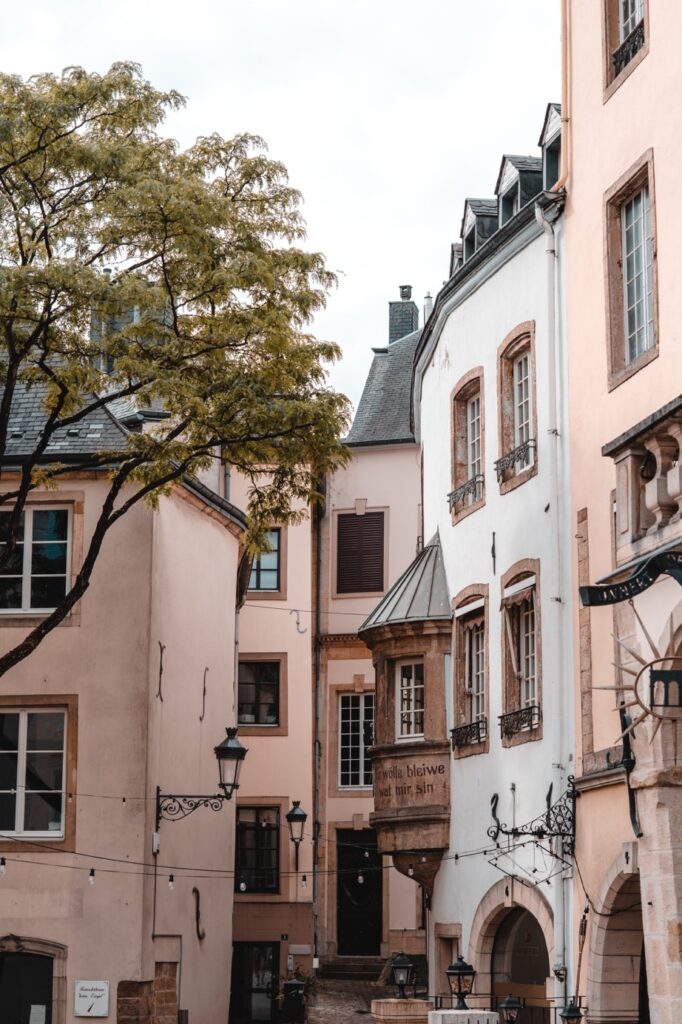
11. Villa Vauban & Parc de la Ville
Built in 1873 as a private residence, the villa owes its name to a fort built on the same site by Sébastien Le Prestre de Vauban (1633–1707) as part of the city’s defences. An impressive section of the old fortress wall can be seen in the museum’s basement. The renovation work, completed in 2010, received the TECO Architecture Award. The museum presents temporary exhibitions based on its own collections, mostly European art from the 17th to the 19th century and Luxembourgish art from the 20th and 21st centuries. The museum is located in the beautiful Municipal Park (Park de la Ville), created by the French architect Édouard André, one of the leading landscape architects of his day, after the demolition of the fortress under the 1867 Treaty of London. The eastern edge flanks the boulevard du Prince Henri and, along with the valleys of the Alzette and Pétrusse, forms a boundary that separates Ville Haute quarter from the rest of the city. It definitively worth the visit!
12. Grand Théâtre de Luxembourg
Since 1869 Luxembourg City’s main theatre had been the Théâtre des Capucins located near the centre of the old town. In December 1958, after the need for a properly designed theatre building had become a priority, a competition was launched with a view to completing the construction work for the millennium celebrations in 1963. The winner was Alain Bourbonnais, a Parisian architect. Work began in autumn 1959 and the theatre was festively inaugurated on 15 April 1964. The Théâtre Municipal de la Ville de Luxembourg is the city’s major venue for drama, opera and ballet. It underwent renovation work in 2002–2003 resulting in substantial improvements to the stage technology, acoustics and lighting facilities.
13. Grand Ducal Palace
“Palais Grand-Ducal” is the official residence of the Grand Duke of Luxembourg where he performs most of his duties as head of state of the Grand Duchy. The building was first the city hall of Luxembourg from 1572, then became the prefecture of the Département des Forêts in 1795, and then the headquarter of the Luxembourg Government in 1817 when it became the residence of the Governor. With the accession of the House of Nassau-Weilburg in 1890 the palace was reserved exclusively for the Grand Duke and his family until today, with only a short interruption during the German occupation in the Second World War when it was used by the Nazis as a concert hall and tavern. The interior of the Palace has been regularly renovated to match modern tastes and standards of comfort.
14. Musée National d’Histoire et d’Art
The MNHA is dedicated to displaying artworks and artefacts from all periods of Luxembourg history. The museum is situated in Fishmarket, the historic heart of the city, in the “Ville Haute” quarter.
The first proposal for such a museum was made during the French occupation of the Revolutionary Wars, however the museum was never opened despite the expropriation of a number of artefacts from the church. With the affirmation of Luxembourg’s independence under the 1839 Treaty of London came a greater interest by native Luxembourgers in promoting the history of their country. In 1845 historians and archaeologists formed the Society for the Study and Preservation of Historic Monuments in the Grand Duchy of Luxembourg, known as the “Société Archéologique”, that took over the responsibility of maintaining a collection of historic antiquities from Luxembourg City’s Athenaeum. In 1868 the Society received a boost from the establishment of the Royal-Grand Ducal Institute, amongst the responsibilities of which was the conservation of archaeological collections.
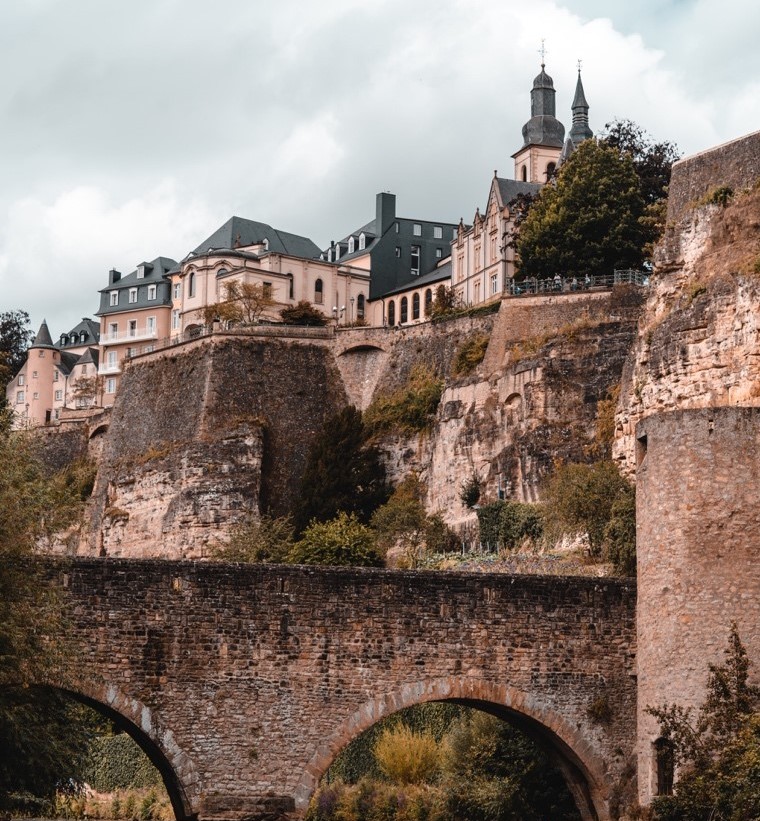
15. Bock Casemates: a UNESCO World Heritage Site
The Bock is a promontory in the north-eastern corner of Luxembourg City’s old historical district. Offering a natural fortification, its rocky cliffs tower above the River Alzette which surrounds it on three sides. It was here that Count Siegfried built his Castle of Lucilinburhuc in 963, providing a basis for the development of the town which became Luxembourg. Over the centuries, the Bock and the surrounding defences were reinforced, attacked and rebuilt time and time again as the armies of the Burgundians, Habsburgs, Spaniards, Prussians and French vied for victory over one of Europe’s most strategic strongholds, the Fortress of Luxembourg. Warring did not stop until the Treaty of London was signed in 1867, calling for the demolition of the fortifications. Ruins of the old castle and the vast underground system of passages and galleries known as the Bock Casemates continue to be a major tourist attraction.
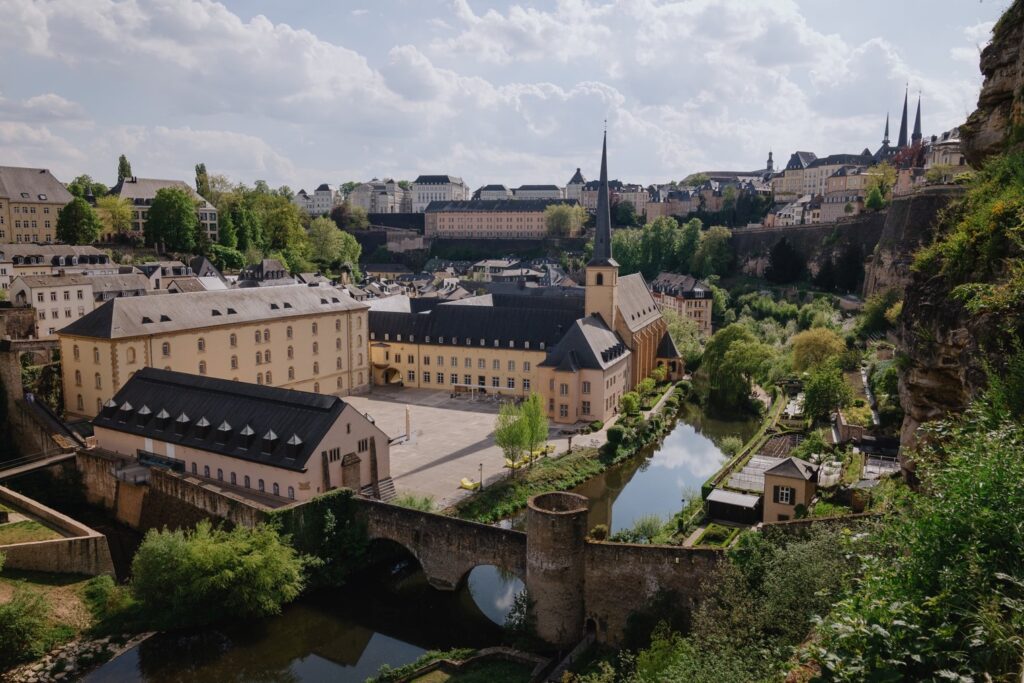
16. Chemin de la Corniche
The Corniche is also known as “the most beautiful balcony in Europe”, it runs along the fortifications built by the Spanish and French in the 17th century along the Alzette valley. The path stretches from the Bock Promontory up to the lower part of the Holy Ghost Citadel, the so-called “Rondellen”. Up to the year 1870 the Corniche had staircases in steep parts which were levelled off only after the dismantling of the fortress. The largest part of the protecting wall with its loopholes was cleared away so as to disclose a superb panorama on the valley of the Alzette, the Grund district and the Rham Plateau.
17. Pfaffenthal Panoramic Elevator
In 2006 Luxembourg City planners, noting the city’s topography of plateaus and deep gorges, began exploring the possibility of a mechanical link to facilitate greater pedestrian and bicycle mobility between the historical city-centre, Ville Haute, on the Luxembourg plateau, and the Luxembourg City quarter of Pfaffenthal in the Alzette valley. Additionally, such a link would increase tourist footfall to Pfaffenthal and complement the existing public elevator connecting Ville Haute to the Luxembourg City quarter of Grund, to the South of Pfaffenthal. This would promote the use of various city walking and bike trails, businesses in the quarter and improve accessibility to Luxembourg City’s UNESCO World Heritage former fortifications. The elevator was opened to the public in 2016. The new Tram line that connects the super-modern Kirchberg plateau to the Old Town stops next to the Elevator, conferring further mobility through the city.
18. Grund Quarter
It is located in the valley below the centre of Luxembourg City on the banks of the Alzette River and, in addition to being a picturesque area, is a popular nightlife precinct that can be accessed by foot or the Pfaffenthal Elevator which descends through the cliff. Between others the Grund is home to Mosconi, a Michelin star Italian restaurant, and Kamakura, a Japanese restaurant, beside a myriad of bars and clubs where both locals and expats gather for live music events all year long.
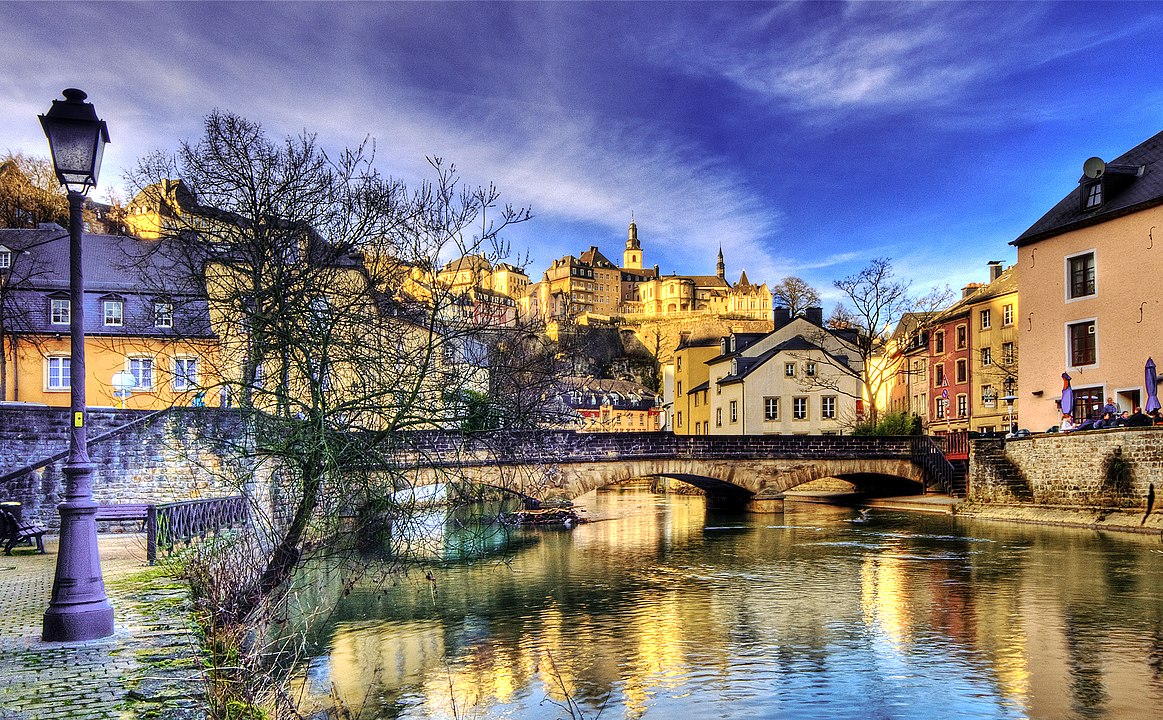
19. National Museum of Natural History
The museum is located in the Grund quarter on the eastern bank of the Alzette river, next to the Neumünster Abbey cultural centre. The museum is composed of eight separate scientific sections, spanning the natural sciences: botany, ecology, geology and mineralogy, geophysics and astrophysics, palaeontology, vertebrate zoology, and invertebrate zoology. It’s educational, lively and unusual.
20. Museum Dräi Eechelen Fortress
Located in the Kirchberg district and opened in July 2012 in the fully restored 18th century Fort Thüngen, its permanent exhibition traces Luxembourg’s history from 1443 to 1903. Fort Thüngen was built by the Austrians in 1732 to reinforce the Fortress of Luxembourg. In 1836 and in 1860 it was extended by the Prussians forming part of the outer defences known as the Grünewald Front. As a consequence of the 1867 Treaty of London, most of the building was demolished apart from its three rounded turrets, colloquially known as Dräi Eechelen (Luxembourgish) or Les Trois Glands (French), meaning „The Three Acorns“. In 1996 the Luxembourg authorities approved the development of a so-called “Musée de la Forteresse” in Fort Thüngen with a view to „illustrating and explaining the nature of the fortress of Luxembourg in regard to the history of the city, the territorial development of the country and the cultural identity of the nation“.
21. MUDAM
The “Musée d’art moderne Grand-Duc Jean” stands on the site of the old Fort Thüngen, on the southwestern edge of the Kirchberg-plateau, in close proximity to many of the European Union institutions based within the city. First proposed in 1989 and championed by then-Prime Minister Jacques Santer, the location of the future museum was much disputed, until it was agreed in 1997 to use Dräi Eechelen Park and connect the museum to Fort Thüngen. The remarkable building was designed by Pritzker Prize-winning architect I. M. Pei and cost about € 100m to build. The museum was inaugurated on 1 July 2006 by Grand Duke Jean, to whom the building is dedicated. As Luxembourg had no public modern art collection and the museum budget did not allow acquiring a modernist collection, the museum focused on contemporary art. Its permanent collection includes works by 100 artists, including Andy Warhol, Bruce Nauman, Julian Schnabel, Thomas Struth and Daniel Buren.
22. Philharmonie Luxembourg
Known officially as the Grande-Duchesse Joséphine-Charlotte Concert Hall, it is a concert hall located in Kirchberg quarter. Opened in 2005, it now plays host to 400 performances each year. The inspiration for constructing a concert hall in Luxembourg is closely linked to the Luxembourg Philharmonic Orchestra. It soon became an important cultural institution of the city, not only for the music but also for the ambitious architecture defining the skyline.
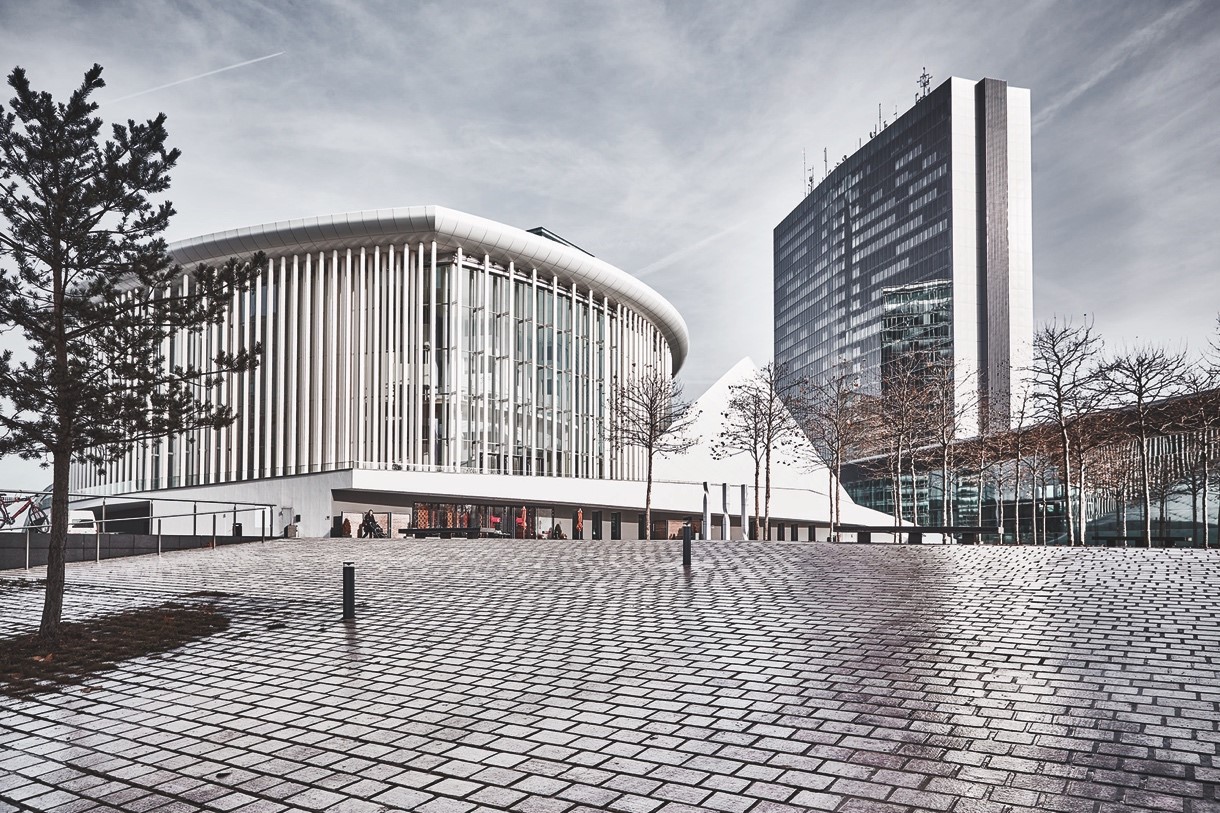
8 good reasons to live in Luxembourg City as an Expat
